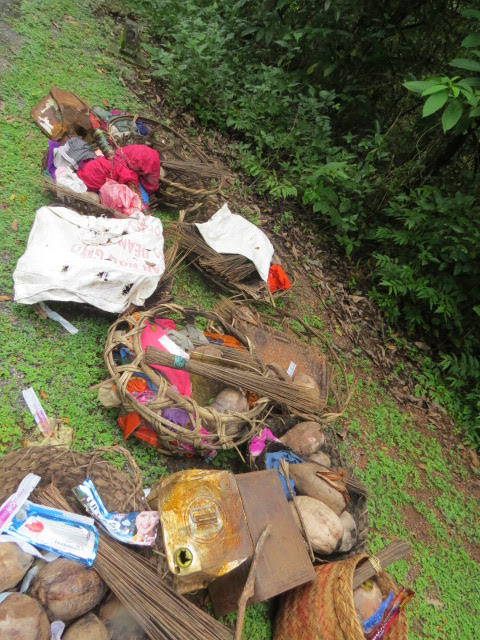When you travel in the car on the highways of the Western Ghats and Coasts of Karnataka you may suddenly notice these strange pile of disposals just beside the road... These are not ordinary garbage disposals. It has got a cultural history and interesting rituals and belief followed by locals.
This waste bundle is called 'Maari hore" (ಮಾರಿ ಹೊರೆ )in Kannada. 'Maari' is the folk Goddess/Deity of misfortunes and epidemics diseases., who is worshiped to seek her blessings for prevention of diseases like smallpox, cholera, plague and also natural calamities. The word ‘Maari’ refers to contagious diseases in Kannada. It appears that originally the concept of Maari worship was conceived to drive out epidemic diseases.
 |
| Near Sagar western ghat highway 2019 June |
 |
| Near Sirsi highway -July 2019 |
The symbolic extradition of Maari, the epidemics, still prevalent along the Western Ghats and coasts of Karnataka.
She is also known adugoolajji (ಅಡುಗೂಲಜ್ಜಿ )or gadi maari (ಗಡಿಮಾರಿ)
The villagers of the next village used to carry the disposals on their head after conducting Poojas (ಉಡಿ ) extradite the idol and the bundles to the outskirts of their village. And this chain continues along with the villages until the bundle reaches the sea or a river
No festivals are celebrated by the village in which Gadimaari is placed. While lifting the garbage (maari), salt packets offered to get rid of minor diseases and piled up by devotees around the year are also cleared.
She is also known adugoolajji (ಅಡುಗೂಲಜ್ಜಿ )or gadi maari (ಗಡಿಮಾರಿ)
Gadi Maari is always kept at the boundary of the village (Gadi means boundary and maari is the goddess of the epidemic )
The image above shows rural custom of leaving the idol of Gadi Maari at the outer boundary of the village after due worship.
The photos were captured in a different year mostly on the highways of Sirsi, Siddapur, Yellapur, Ankola, Kumta, Honnavar, Sagar, Shivamogga.
What is this Maari hore ( waste disposal bundle )contains?
The entire dump is called maari hore. Interestingly earlier these garbage bundles (maari hore) contained all eco-friendly discarded broken household items. Mostly it contained broken woven cane baskets, broken woven cane cradles, rice winnowing flat basket) brooms, broken earthen pots, waste cloths and loads of salt packets .. Deities also offered coins, green bangles, coconut as UDI.
Recent maarihore contains mostly plastic waste ..Recently vehicles are hired to lift the Maarihore when it reaches to the towns and they describe the reason that Maarihore becomes a huge pile when it is almost reaching its destination.
The maari hore is also evolving ..earlier it was just a bundle of eco-friendly disposals. Now we can see the wooden statue of the female goddess and a male god along with disposal ..there is a big wooden toy cart also be offered as an imaginary goods carrier ..
The concept of maari hore is a great example of effective waste disposal management. The waste travels from village to village until it reaches the sea or a river. unfortunately now maaarihore is no more eco-friendly garbage bundle ..it contains all kind of plastics .. but the rituals and faith continue
The entire dump is called maari hore. Interestingly earlier these garbage bundles (maari hore) contained all eco-friendly discarded broken household items. Mostly it contained broken woven cane baskets, broken woven cane cradles, rice winnowing flat basket) brooms, broken earthen pots, waste cloths and loads of salt packets .. Deities also offered coins, green bangles, coconut as UDI.
Recent maarihore contains mostly plastic waste ..Recently vehicles are hired to lift the Maarihore when it reaches to the towns and they describe the reason that Maarihore becomes a huge pile when it is almost reaching its destination.
 |
| Photo :Nandan Aigal |
 |
| Photo: Nanadan Aigal |
 |
| Near Sagar high way June 2019 |
 |
| Sirsi highway july 2019 |
Ankola culture history and ecology.








